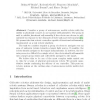Free Online Productivity Tools
i2Speak
i2Symbol
i2OCR
iTex2Img
iWeb2Print
iWeb2Shot
i2Type
iPdf2Split
iPdf2Merge
i2Bopomofo
i2Arabic
i2Style
i2Image
i2PDF
iLatex2Rtf
Sci2ools
ECAL
2005
Springer
2005
Springer
Self-assembly on Demand in a Group of Physical Autonomous Mobile Robots Navigating Rough Terrain
Consider a group of autonomous, mobile robots with the ability to physically connect to one another (self-assemble). The group is said to exhibit functional self-assembly if the robots can choose to selfassemble in response to the demands of their task and environment [15]. We present the first robotic controller capable of functional self-assembly implemented on a real robotic platform. The task we consider requires a group of robots to navigate over an area of unknown terrain towards a target light source. If possible, the robots should navigate to the target independently. If, however, the terrain proves too difficult for a single robot, the robots should self-assemble into a larger group entity and collectively navigate to the target. We believe this to be one of the most complex tasks carried out to date by a team of physical autonomous robots. We present quantitative results confirming the efficacy of our controller. This puts our robotic system at the cutting edge of autonomou...
| Added | 27 Jun 2010 |
| Updated | 27 Jun 2010 |
| Type | Conference |
| Year | 2005 |
| Where | ECAL |
| Authors | Rehan O'Grady, Roderich Groß, Francesco Mondada, Michael Bonani, Marco Dorigo |
Comments (0)

